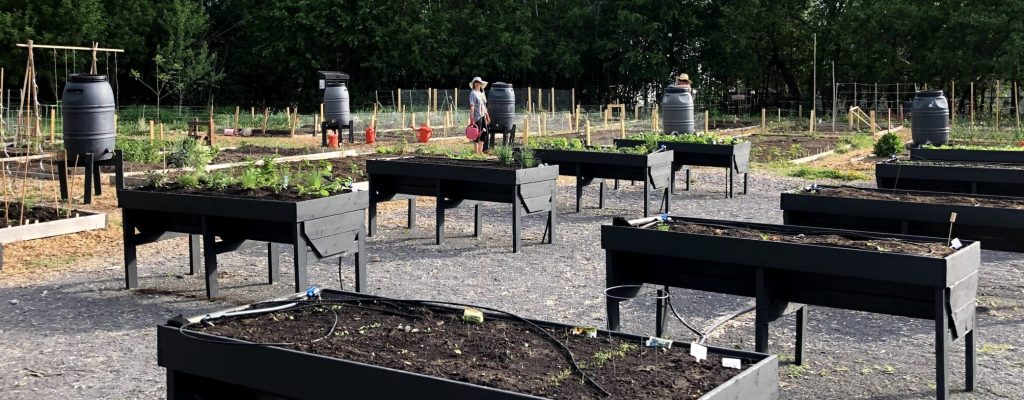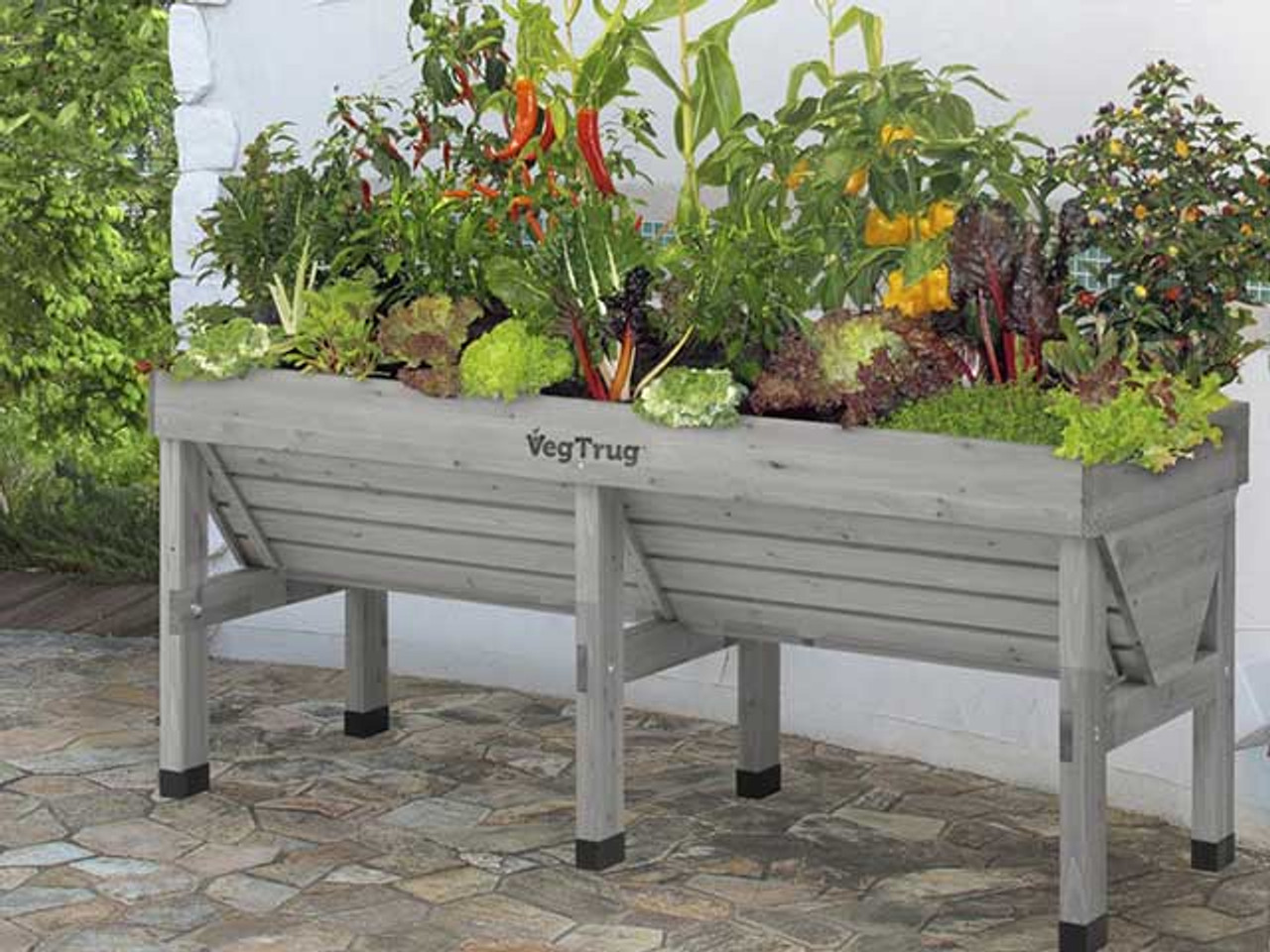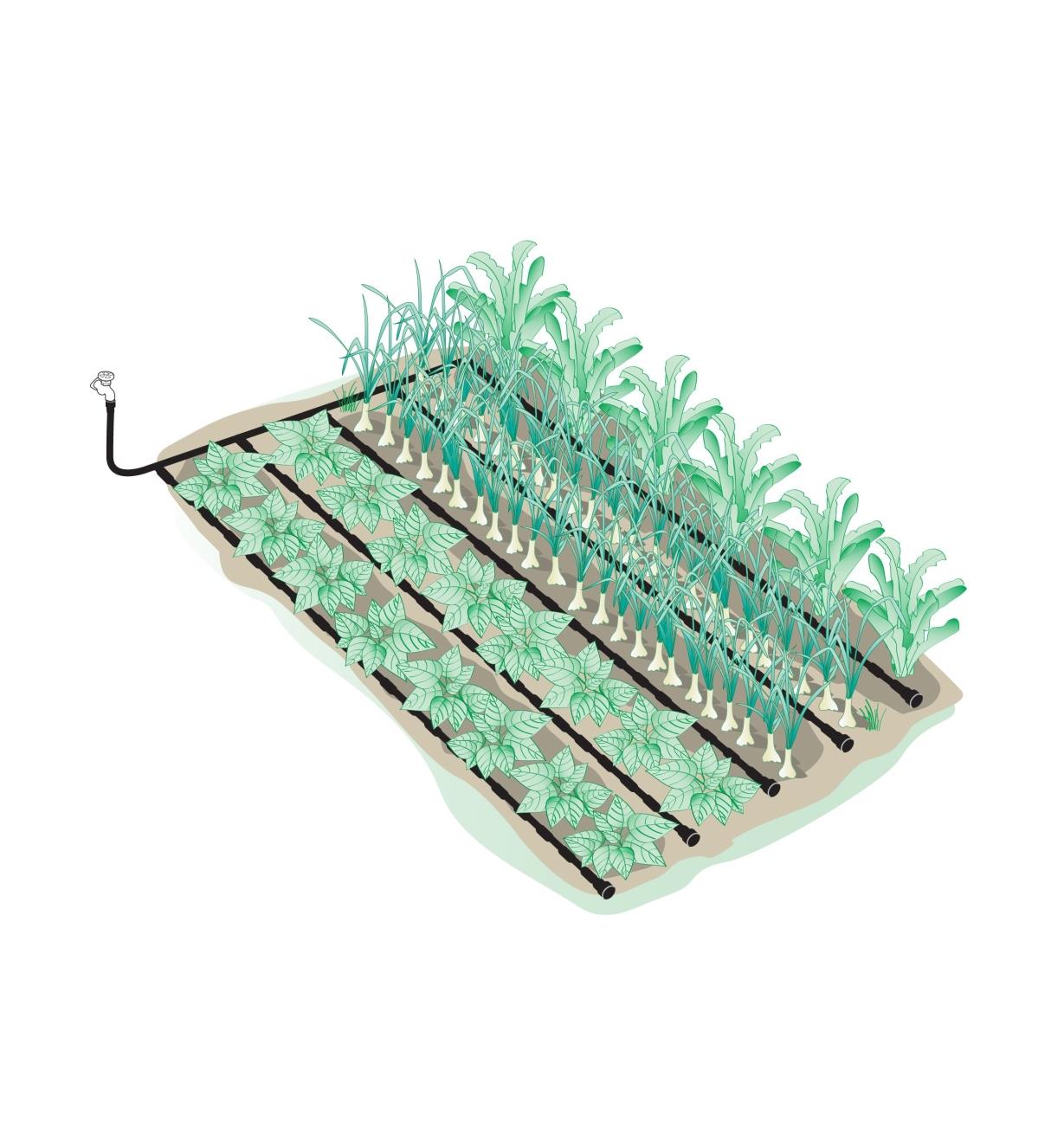
What is accessible gardening?
Gardening is an activity that can be enjoyed by everyone.
Some folks may experience challenges like limited mobility, injuries, physical or mental illness, sensory conditions, and more.
There are many ways we can address these challenges by modifying practices, changing setups, or purchasing supports.
Explore below for an overview of some options to take into consideration when looking to make your (or your loved one’s/neighbour’s/community’s) gardening experience more accessible.
Special thanks to the Ottawa Disability Coalition for their collaboration on providing this information to gardeners across the city!
Gardening for People using Wheelchairs or with Limited Mobility
Pathways and Access
Ensure that all pathways are clear of debris and as level as possible.
Appropriate materials to use for a path may include:
- compact small-piece, crushed gravel
- pavers
- bricks and stone
- mulch (dependent on type, as large pieces may be difficult to navigate over)
Path width must be no less than 850mm, but 1800mm is ideal (consider the layout too, to ensure there is space to turn around comfortably). These measurements are according to the City of Ottawa Accessibility Standards.
Some plants may grow over the sides of your beds, so it is important to make sure they do not impede pathway use. Trim as needed.
Pathways should be properly maintained to ensure there are no cracks or unevenness that can become hazardous.
Raised Gardens
Raised gardens allow for those with limited mobility or who use mobility devices like wheelchairs to comfortably access the growing space.
The City of Ottawa accessible raised bed standards show that an appropriate height is 30″ to 36″ tall. This height allows for minimal bending/reaching.
Special consideration:
If space allows, consider having multiple raised beds in varying heights.
Different crops will grow to different heights, and an especially tall plant (such as an indeterminant tomato) may become difficult to maintain or harvest from in a bed that is 36″ tall.
Having beds that are 24″ tall will help accommodate some of those taller plants, but may not be as comfortable to use for root crops or low-growing greens.
Table top garden beds
 The benefit to using a table top garden bed is that users are able to forward-face when gardening, which can prevent overextended twisting and reaching.
The benefit to using a table top garden bed is that users are able to forward-face when gardening, which can prevent overextended twisting and reaching.
In order for a person in a wheelchair or someone sitting to be able to slide underneath, there needs to be about 28″ clearance off the ground.
These beds are ideal for low height crops, such as carrots, radishes, lettuces, herbs, etc.
There are many plans available to build a table top raised bed, but for an example on where to purchase one, head over to this link.
Galvanized steel raised beds
 If you are interested in a raised bed option that is relatively easy to assemble, we recommend you head over to raisedgardenbeds.ca to view their selection.
If you are interested in a raised bed option that is relatively easy to assemble, we recommend you head over to raisedgardenbeds.ca to view their selection.
These beds, manufactured by Conquest Steel, are made using food-safe materials specifically for raised garden beds. They are available in varying heights and sizes.
Galvanized steel raised beds are a sustainable option, as they have a long lifespan, and are comparable in price to building a wooden bed.
Use containers on raised surfaces
 Instead of building or purchasing an entire raised garden bed, you may want to consider using containers placed on top of raised surfaces (such as a table or shelf).
Instead of building or purchasing an entire raised garden bed, you may want to consider using containers placed on top of raised surfaces (such as a table or shelf).
This can be a cost-effective and simple way to garden comfortably, but there are additional considerations to take:
- Containers and pots can move around in inclement weather. Ensure they (and your raised surface) are secure and unlikely to tip.
- Soil, especially when wet, is heavier than you may think! Avoid needing to move your containers as much as possible.
- When gardening in containers, you will need to make sure there is good drainage with holes in the bottom.
- Because your containers and pots will need to allow water to flow through, you’ll also want to protect the surface that your containers sitting on.
Reach out to our CGN Coordinator by email!
Gardening with Impaired Vision or Blindness
Impaired Vision or Blindness
- Use textured materials/markers to indicate pathways, plants, tool storage, etc
- Plant hardy crops that aren’t as sensitive to touch
- i.e. kale is stronger than a green leaf lettuce
- Use brightly coloured tools (or add bright tape to handles) so they are easier to find
- Appeal to your sense of smell by planting strongly scented crops (especially herbs)
- Keep a toolbox close by or directly in your growing site for easy access
- Use short-handled tools to maximize your control when gardening
Colour Blindness
- Label your plants well, using large, sturdy plant markers (i.e. wood)
- Appeal to your sense of smell by planting strongly scented crops
- Grow crops that rely less on colour to determine ripeness
- i.e. carrots, radishes, potatoes, beans, peas, etc can be harvested when a certain size
- peppers, berries, tomatoes may be more challenging to determine the best time to harvest
Gardening with Neurodivergence or Mental Health Conditions
Here are some ideas for ways to set yourself up with support!
Not all of these ideas are right for everyone. Please allow yourself grace as you learn what works best for you.
Label everything! (plants, tools, organizational spaces, etc)
- Get in the habit of “over-labelling” (especially for sowing seeds or planting seedlings). If your attention is redirected elsewhere for an extended period of time, you will be able to hop right back in to your project when you’re ready.
Have multiples of your most-used tools
- Keep an eye out on your Buy Nothing Groups and at local garage sales to pick up spares of your favourite tools.
- Misplacing items or the anticipation of having to look for your tools may be a barrier for some folks. By keeping multiple shears or clippers (for example), they’ll be more readily available for you to grab on your way to the garden.
Have a tool box that is easy to move around
- Keep all of your tools in one spot that you can take with you as you move around the garden.
- Put labels, markers, string, scissors, clippers, etc in the one bag, so you can easily access your tools and have a quick spot to put them away when you’re done.
Add brightly coloured tape or paint to your tools
- If you’re out in the garden and your attention is redirected elsewhere, being able to easily locate your tools quickly will take away the barrier of getting back to the garden.
Connect with likeminded individuals
- Build a support system with fellow gardeners where you can check in on each other or offer support (i.e. have garden days at each person’s house to help plant or clean up)
- Not sure where to start? Contact the Community Gardening Network Coordinator to chat about ideas of where to meet gardeners!
Set reminders in your calendar for the whole growing season
- Be mindful in case this becomes a source of anxiety.
Some people may thrive with reminders to tend to their garden, but some may have negative associations with reminders which can cause them to become overwhelmed. - If you feel reminders would be a useful tool for you, consider adding the following
- Watering reminder every 3rd day (may be daily at the height of summer)
- Weeding reminder every second week
- Plant maintenance (tying up, trimming, pruning, etc) alternating weeks
- These reminders may be more or less frequent as you figure out your capacity to garden
Explore our “Practices to Adopt” tab below for more information on the benefits of:
- Perennial Edible Gardening
- Mulching
- Irrigation Systems
- Seating/Storage for frequent breaks
Practices to Adopt
Adopting the following practices can help ease both physical and mental strains that may arise when gardening.
While we acknowledge gardening to be a therapeutic activity on multiple levels, it can also be a source of stress when you are experiencing high-pain days or mental health struggles.
By adding these practices to your garden, you can alleviate some of the responsibilities that come with growing plants (i.e. watering or weeding).
Mulching
Apply a layer of mulch over your garden beds.
Why? Mulching suppresses weeds and retains water.
This means you can spend less time pulling weeds and will not need to worry about rushing out to water when you’re not feeling up to it.
(Image: Shredded cedar mulch from Greely Sand & Soil)
What mulches should you use?
- dried leaves
- dried glass clippings (not fresh)
- fine wood chips (natural, not dyed)
- straw
- look for organic straw from a local source, to ensure you are not introducing harmful chemicals to your garden
- avoid hay for mulching, as hay still contains the seed head
- hay is excellent for adding nutrients to soil, but not when our goal is to minimize weeding!
Irrigation
 Adding an irrigation system takes pressure off remembering to water, or allows grace for days when you are not in a position to do so.
Adding an irrigation system takes pressure off remembering to water, or allows grace for days when you are not in a position to do so.
Drip irrigation is a series of hoses that have been perforated with small holes, which emit water at a slow pace. You can even set your watering system up on a timer!
(Image: Irrigation kit from Lee Valley Tools)
Another benefit to using an irrigation system is that your plants much prefer this type of watering. When plants are watered from above, their leaves tend to get very wet. This can sometimes invite plant diseases to spread and harm your crops.
Plant edible perennials
 By planting edible perennials, you decrease the amount of time and effort needed on a regular basis to maintain an edible garden.
By planting edible perennials, you decrease the amount of time and effort needed on a regular basis to maintain an edible garden.
Consider specifically planting edible native perennials. They are naturally better able to survive our climate throughout inclement weather conditions and are suited to survival without additional watering and care.
These plants will continue to feed you and provide a low-input method of growing food.
Want to learn more?
Check out Forêt Capitale Forest
Add seating and storage
 Keep at least one seating area in your growing site to allow for frequent breaks. If you are gardening in a larger space, consider adding more seating areas throughout.
Keep at least one seating area in your growing site to allow for frequent breaks. If you are gardening in a larger space, consider adding more seating areas throughout.
Having a place close to your growing site where you can store your frequently used gardening tools will prevent you from having to make trips to and from a shed.
You also won’t need to carry them for as long.
Combine the two!
Check out some of the neat seating/storage combinations that are readily available at your local department stores to make the most of your space.
Accessible Tools
- There are many tools that can be used to provide gardeners with support.
Explore this list of available accessible tools:
Ergonomic garden hand tools
- Specially designed to have minimal wrist movement. Ideal for those who might struggle with wrist/hand complications.
- Specially designed to have minimal wrist movement. Ideal for those who might struggle with wrist/hand complications.
Garden Kneeler and Seat
- This tool allows for gardeners to kneel or sit down more comfortably while gardening. They are often collapsible/portable.
- Folding Kneeler Stool from Lee Valley Tools
- Kneeler Seat from Canadian Tire
- This tool allows for gardeners to kneel or sit down more comfortably while gardening. They are often collapsible/portable.
Long reach garden tools (extended/telescopic handles)
- Tools that have a longer reach allow mobility limited gardeners to reach further away without causing unnecessary physical strain.
- Tools that have a longer reach allow mobility limited gardeners to reach further away without causing unnecessary physical strain.
Add-on handles
- Universal fit add-on handles ca provide support for larger tools that may be more challenging to use. These provide additional leverage for shovels, rakes, weedwhackers, etc.

- Tool Handle Attachment from BotanicGardens.ca
- Universal fit add-on handles ca provide support for larger tools that may be more challenging to use. These provide additional leverage for shovels, rakes, weedwhackers, etc.
Lower effort garden shears
- Lower effort garden shears, such as ratchet or telescopic garden shears, require less force to cut plants.
- Ratcheting Hand Pruner from Lee Valley Tools
- Fiskars Telescoping Power Lever Hedge Shears from Canadian Tire
- Lower effort garden shears, such as ratchet or telescopic garden shears, require less force to cut plants.
Additional Tools to Consider
- Watering cans: Look for a watering can with a comfortable handle and a long neck to allow for further reach when watering.
- Storage boxes: If you don’t have a shed that holds your garden tools, look for an outdoor storage box that will be easy for you to access and reach into. If possible, visit your local garden centre to test them out in advance.
- Short-handled tools: For those with limited vision, shorter-handled tools may allow for easier control when gardening.
Horticultural Therapy
(From the Canadian Horticulture Therapy Association🙂
Horticultural Therapy (HT) is a formal practice that uses plants, horticultural activities and the garden landscape to promote well-being for its participants. HT is goal orientated with defined outcomes and assessment procedures. HT sessions are administered by professionally trained horticultural therapists.

Root in Nature connects people with the healing power of plants to improve their overall mental, physical and emotional wellbeing.
They are located here in Algonquin land/Ottawa, and offer both in-person and virtual sessions. Visit their website for more resources and to connect for local therapeutic horticulture.
Additional Resources
Looking to dive a little deeper? Here’s some resources to check out!
This video, produced by Graying with Grace, provides visuals and technical information on ways you can set up a wheelchair accessible garden.
Earth Undaunted
This blog by Erin Alladin contains excellent resources for accessible gardening.
Their digital book, Gentle Gardening: A low-energy guide for uncooperative bodies provides a thorough approach to setting yourself up to garden with success.About Gentle Gardening: A low-energy guide for uncooperative bodies:
“Yes, you can garden too! Even if you’re short on resources, or energy, or time. Even if you live with chronic illness, pain, disability, brain fog, sensory issues, or low mobility.
In Gentle Gardening, I share the techniques, tips, and mindset shifts that have kept me joyfully gardening through years of illness, pain, and procedures. Whether you yearn to grow roses or radishes, discover how to tend a garden that will nurture YOU in return.”
– Erin Alladin
AccessibleGardens.com
While this company creates beautiful raised beds, they do not currently ship to Canada; however, their website provides inspiration for building your own raised beds. Their FAQs have some interesting information on growing in tabletop gardens, too!


